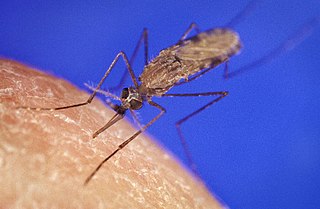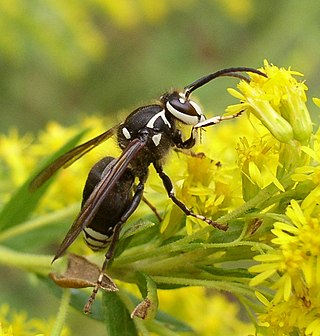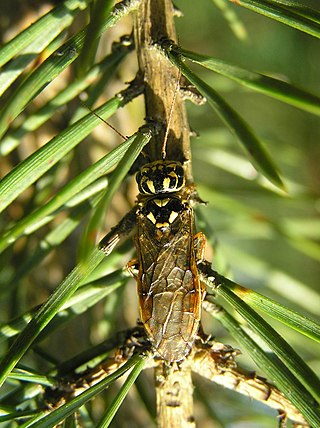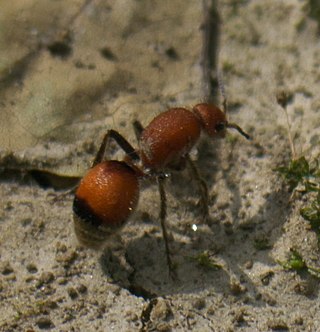
The Mutillidae are a family of more than 7,000 species of wasps whose wingless females resemble large, hairy ants. Their common name velvet ant refers to their resemblance to an ant, and their dense pile of hair, which most often is bright scarlet or orange, but may also be black, white, silver, or gold. Their bright colors serve as aposematic signals. They are known for their extremely painful stings,, and has resulted in the common name "cow killer" or "cow ant" being applied to the species Dasymutilla occidentalis. However, mutillids are not aggressive and sting only in defense. In addition, the actual toxicity of their venom is much lower than that of honey bees or harvester ants. Unlike true ants, they are solitary, and lack complex social systems.

Sawflies are wasp-like insects that are in the suborder Symphyta within the order Hymenoptera, alongside ants, bees, and wasps. The common name comes from the saw-like appearance of the ovipositor, which the females use to cut into the plants where they lay their eggs. The name is associated especially with the Tenthredinoidea, by far the largest superfamily in the suborder, with about 7,000 known species; in the entire suborder, there are 8,000 described species in more than 800 genera. Symphyta is paraphyletic, consisting of several basal groups within the order Hymenoptera, each one rooted inside the previous group, ending with the Apocrita which are not sawflies.

The Culicomorpha are an infraorder of Nematocera, including mosquitoes, black flies, and several extant and extinct families of insects. They originated 176 million years ago, in the Triassic period. There are phylogenetic patterns that are used to interpret bionomic features such as differences in the nature of blood-feeding by adult females, daytime or nighttime feeding by adult females, and occurrence of immature stages in aquatic habitats.

Vespoidea is a superfamily of wasps in the order Hymenoptera. Vespoidea includes wasps with a large variety of lifestyles including eusocial, social, and solitary habits, predators, scavengers, parasitoids, and some herbivores.

The Tiphiidae are a family of large, solitary wasps whose larvae are parasitoids of various beetle larvae, especially those in the superfamily Scarabaeoidea. Until recently, this family contained several additional subfamilies, but multiple studies have independently confirmed that these comprise a separate lineage, and are now classified in the family Thynnidae.

Rhopalosomatidae is a family of Hymenoptera containing about 68 extant species in four genera that are found worldwide. Three fossil genera are known.

Anaxyelidae is a family of incense cedar wood wasps in the order Hymenoptera. It contains only one living genus, Syntexis, which has only a single species, native to Western North America. Fossils of the family extend back to the Middle Jurassic, belonging to over a dozen extinct genera, with a particularly high diversity during the Early Cretaceous. Syntexis lay eggs in the sapwood of conifers, preferring recently burnt wood.

The Pamphilioidea are a small superfamily within the Symphyta, containing some 250 living species restricted to the temperate regions of Eurasia and North America. These hymenopterans share the distinctive feature of a very large, almost prognathous head, which is widest ventrally.

The Bradynobaenidae are a family of wasps similar to the Mutillidae, differing most visibly in the presence, in females, of a suture separating the pronotum from the mesonotum. These species are often found in arid regions.

Cephidae is a family of stem sawflies in the order Hymenoptera. There are about 27 genera and more than 160 described species in Cephidae.

The Thynnidae are a family of large, solitary wasps whose larvae are almost universally parasitoids of various beetle larvae, especially those in the superfamily Scarabaeoidea. Until recently, the constituents of this family were classified in the family Tiphiidae, but multiple studies have independently confirmed that thynnids are a separate lineage.

The Chyphotidae are a family of wasps with wingless females similar to the Mutillidae, differing most visibly in the presence, in females, of a suture separating the pronotum from the mesonotum. These species are found primarily in arid regions in the southwestern United States and adjacent regions in Mexico.

The Myrmosidae are a small family of wasps very similar to the Mutillidae. As in mutillids, females are flightless, and are kleptoparasites in the nests of fossorial bees and wasps.

Miroidea is a superfamily of true bugs in the order Hemiptera. There are about 7 families and more than 15,000 described species in Miroidea.

Myrmelachistini is a tribe of ants in the family Formicidae. There are at least 2 genera and 50 described species in Myrmelachistini.

Heloridae is a family of wasps in the order Hymenoptera known primarily from fossils, and only one extant genus, Helorus, with 12 species found worldwide. Members of Helorus are parasitic on green lacewings.

Pompiloidea is a superfamily that includes spider wasps and velvet ants, among others, in the order Hymenoptera. There are 4 families in Pompiloidea.

Myzinum is a genus of wasps in the family Thynnidae. There are 63 species presently recognized in Myzinum. They measure 7–24 mm. They are found in meadows, fields, and lawns. They parasitize white grubs, including Phyllophaga. They are used as biological controls.

Thynnoidea is a superfamily of hymenopterans in the order Hymenoptera. There are 2 families and hundreds of described species in Thynnoidea.
Eriaporinae is a subfamily of chalcid wasps in the order Hymenoptera, family Pirenidae. There are 2 genera and 6 described species in Eriaporinae.




















